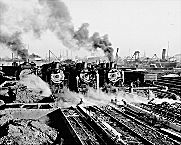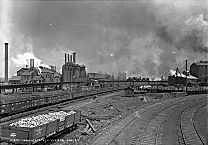| Entries |
| I |
|
Iron and Steel
|

|
The emergence of a large iron and steel industry in the Chicago region during the nineteenth century was a function of entrepreneurial effort and geographical advantage. Mills could obtain raw materials from the vast iron ore deposits in the Lake Superior region relatively cheaply and easily. Because most of the iron ore used by the American steel industry during its rise was mined in Minnesota and Michigan, mills located along the Great Lakes were well positioned to enjoy lower costs than their competitors elsewhere, especially after 1924, when U.S. government regulators ended the “Pittsburgh Plus” pricing system that had protected Pennsylvania mills from competition.

|

|
During the first part of the twentieth century, even after many of Chicago's largest mills were absorbed into a giant national corporation, the area's importance within the American steel industry continued to rise. The most important single development in the history of the industry occurred in 1901, when New York banker J. P. Morgan engineered the creation of U.S. Steel, the world's largest business enterprise. Illinois Steel (by then also known as Federal Steel, a holding company created by Chicago lawyer Elbert H. Gary in 1898) became part of this giant entity. U.S. Steel closed some of the Chicago-area mills, but the South Works—which employed about 11,000 people in 1910—stood as one of its largest plants. And in 1906, U.S. Steel built a huge new mill on south shore of Lake Michigan in what would become Gary, Indiana. By the 1920s, the Gary Works had 12 blast furnaces and over 16,000 employees, making it the largest steel plant in the country.
Although it dominated the industry, U.S. Steel was not the only important steel company in the Chicago area during the early twentieth century. Several local companies also operated large mills in the Calumet district and northern Indiana. Inland Steel, which was established in Chicago Heights in 1893, became a major player in the steel industry in 1901 when it decided to build a large new plant at Indiana Harbor. Inland Steel grew steadily through the 1930s, when the Indiana Harbor plant had four blast furnaces and over 9,000 employees. Another important local plant was the South Deering facility of Wisconsin Steel, which supplied metal to International Harvester, its Chicago-based corporate parent. Other important steel companies in the area during the early twentieth century included Republic Steel, Acme Steel, Youngstown Sheet & Tube, and Interlake Iron. Together with the U.S. Steel plants, all of these smaller companies made the Chicago area an increasingly important center of steel production.
The growth of the steel industry during the early twentieth century was accompanied by serious conflict between companies and their employees. Iron- and steelworkers in the Chicago area had been forming associations since the middle of the nineteenth century. Starting in the 1870s, hundreds of them became members of the Amalgamated Association of Iron and Steel Workers, a national group. During the first part of the twentieth century, Amalgamated and other groups led organized efforts designed to win higher wages, shorter hours, and safer working conditions. Many steelworkers at this time worked 12-hour shifts, six or seven days a week, in hazardous environments. For the most part, strikes at Chicago-area plants between 1900 and 1920 ended in defeat for workers. The largest of these strikes occurred in 1919, when 90,000 Chicago-area workers led an industrywide, national protest coordinated by the American Federation of Labor (AFL) that sought union recognition and the 8-hour day. The strike temporarily halted steel production, but, after state and federal troops were called in, workers returned to their plants. A nationwide collapse followed soon thereafter. When the steel industry agreed to an 8-hour day in 1923, the change resulted more from public pressure and the efforts of U.S. president Harding than from the strength of organized labor.
During the 1930s, in the midst of the Great Depression and the reforms of the New Deal, steelworkers in the Chicago area and across the nation finally won substantial gains through unionization. The successful unionization efforts of the 1930s brought together tens of thousands of workers of various ethnic backgrounds. At the turn of the century, most steelworkers in the Calumet and Indiana mills had been immigrants from Southern and Eastern Europe. During the 1910s and 1920s, large numbers of Mexican and African American men found work in the mills. Often, area steel companies attempted to exploit ethnic differences among workers to fight unionization. For many years, steelworkers were divided by ethnicity and craft distinctions. But in the late 1930s, after New Deal legislation made unionization easier, workers were organized across the industry. In Chicago and elsewhere, Amalgamated joined the Steel Workers Organizing Committee of the Congress of Industrial Organizations (CIO) in launching a 1936 organization drive that won recognition by U.S. Steel in 1937. The most violent of the Chicago-area clashes accompanying this effort was the “ Memorial Day Massacre, ” in which 10 people were killed by police gunfire during a strike outside the East Side plant of Republic Steel. But this incident did not prevent unionization, and, in 1942, steelworkers formed a powerful national union, the United Steelworkers of America (USWA). By the beginning of the 1970s, when the USWA counted 130,000 members in the Chicago region, the predominant ethnic groups in the mills were Mexicans and African Americans.
From the 1940s until the 1970s, the steel industry remained one of the Chicago area's leading economic sectors. Immediately after World War II, the United States was making over half the world's steel, and mills in Indiana and Illinois accounted for about 20 percent of total U.S. production capacity. Many of the large open-hearth plants established in the early part of the century continued to make huge amounts of steel. Between 1959 and 1964, Interlake and Wisconsin Steel became two of the first U.S. mills to install basic oxygen furnaces, which were faster and cheaper than the older open-hearth equipment. Meanwhile, a large new plant was built by Bethlehem Steel at Burns Harbor, Indiana. The last giant mill constructed in the Chicago region, the Bethlehem plant helped make the Illinois-Indiana region the geographical center of the U.S. steel industry at the end of the 1960s.
During the Cold War, when most Chicago-area steelworkers were represented by the USWA, relatively high wage levels did not prevent labor conflict. Between 1945 and 1959, there were five industrywide strikes. In 1952, about 80,000 Chicago-area steelworkers walked out for two months. An even more serious work stoppage occurred in 1959, when tens of thousands of workers in the Chicago area joined 500,000 steelworkers nationwide in a four-month strike to win changes in work rules, wage levels, and benefits.
During the 1970s and 1980s, the U.S. steel industry suffered a sudden collapse that threw thousands out of work. U.S. Steel and other American steel companies that still depended upon large numbers of older, inefficient plants failed to withstand the combination of a decline in demand and the rise of international competition in the 1970s. The sudden decline of American steel stunned the employees of mills across the Chicago area. Between 1979 and 1986, about 16,000 Chicago-area steelworkers lost their jobs. Wisconsin Steel closed abruptly in 1980 after attempts at a financial bailout failed. South Works endured a prolonged shutdown before closing its doors in 1992. Inland Steel cut thousands of workers. Republic Steel dismissed half its employees. In 1984, it merged with LTV Steel, which declared bankruptcy in 1986. The closures left many steelworkers without jobs or health care and decimated communities in northwest Indiana and the Calumet district.
During the final years of the twentieth century, the Chicago region continued to be a leading center of production in an American steel industry that was much weaker and smaller than it had been before. By the mid-1980s, the area was home to several “minimills,” small-scale plants that used sophisticated electric furnaces to recycle scrap metal. By the end of the 1980s, mills in Northern Indiana were making about a quarter of all the steel produced in the United States. While the region remained a center of steel production, the industry was no longer the powerhouse that had been a crucial part of the Chicago-area economy for over a century.
The Encyclopedia of Chicago © 2004 The Newberry Library. All Rights Reserved. Portions are copyrighted by other institutions and individuals. Additional information on copyright and permissions.